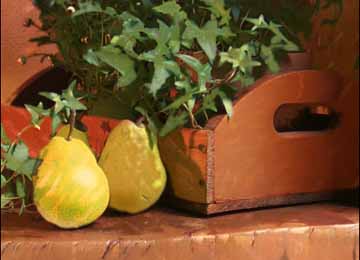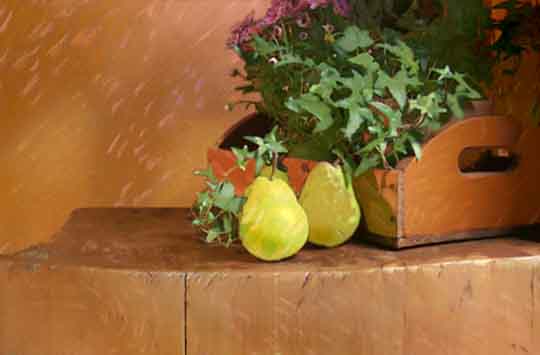|
|
Using the Dodge and Burn Tools
|
By Rick Wetzel
In my Monthly Tip 2, I applied a watercolor texture to a photograph. and the effect was quite nice. This month's tip goes one step farther. We'll add dimension to the texture without resorting to airbrushing a tone on top of the texture. By using the Dodge and Burn tools in Photoshop, you can retain the underlying color. |
|
|
|
I started with a photograph that I took with my digital camera. I used available light and a little fill with a tungsten flood. No flash.
I could have spent more time with the lighting, but I wanted to demonstrate what you can do with just a good picture.
|
|
|
Using just one Digital Pastel, from my latest collection, I Copied and Pasted Into selected areas of my photograph. You can review this technique in monthly Tip #2.
I could have stopped here, but I wanted to add some dimension to the pears and restore the gradation of the side panel of the tray.
This brings me to this installment - Using the Dodge and Burn Tools.
|
|
I cropped in tight for this part of my Tips. Make sure you work in Layers. You'll have built in masks!
I first wanted to give the left pear some additional dimension. I choose the Burn tool, selected a 50% exposure, and selected shadows from the Burn palette. With the proper layer selected, I burned in shadow. For the highlight, I choose the Dodge tool, selected a 50% exposure, and selected highlight from the Dodge palette.
|
|
This is a good example of how airbrushing a lighter tone would have killed the underlying texture.
For the side of the tray, I selected the appropriate layer, and used the Dodge Tool. This time I change the brush size to 300.
|
 |

|
The final photo-illustration using the Dodge and Burn technique with Digital Pastels for Photoshop.
|
|
©1999, Wetzel & Company, Inc.
|
|